|
Artists
Architecture
Poems
Photography
Quotes
Religion
Stories
Themes
China
Japan
Russia
|

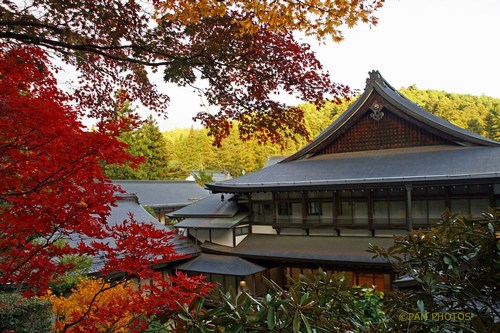
Court ranking system Culture
Glossary
Kimono
Modern Art
Prints Religious
Art
Society
Tenno
Court ranking system
The eight court
ranks conferred on the officials according to the importance of the
posts they held in the Council of State were as follows:
Chancellor
(Number of persons: 1, Court Rank: first)
|
Minister of the Left (1, second) |
Minister of the Right (1, second) |
|
Great Councilors (4, third) |
Minor Councilors (4, third) |
|
Controllers of Four Departments of
Central Affairs, Ceremonial, Civil Administration, Popular
Affairs (4, fourth) |
Controllers of Four Departments of Military Affairs, Justice,
Treasury, Royal Household (4, fourth) |
|
Vice-Controllers (4, fifth) |
Vice-Controllers (4, fifth) |
|
Secretaries (4, sixth) |
Secretaries (4, sixth) |
|
Minor Secretaries (4, seventh) |
Minor Secretaries (4, seventh) |
|
Recorders (4, eighth) |
Recorders (4, eighth) |
The third court rank and above were constituted as peerage. In the case
of the university under the control of the Department of Ceremonial, the
president and professors of literature held the fifth; professors of
Chinese classics held the sixth; professors of Chinese pronunciation,
calligraphy and mathematics held the seventh.
The holders of these ranks were granted stipends.
Everyone who can explain more, or add something interesting about
this item, please, send it to:
cedars@live.nl
* * * * * * * * * * * * * *
* * * * * * * * * * * * * * * *
TOP * * * * * * * * * * * *
* * * * * * * * * * * * * * * * * * *
Culture
The Takarazuka Revue
The Takarazuka Revue is a Japanese all-female musical
Theater in the city of Takarazuka, Japan. Women play both male and
female roles in lavish productions, often Western-style musicals, but
always with strong Japanese elements.
The all-female Takarazuka Revue Company touches something deep in the
Japanese psyche, or at least the female Japanese psyche. Many of the
fans are female and most of them are young. And the stars they adore
most are the otokoyaku, the actresses who play the male parts. In
Japan's male-dominated society the otokoyaku represent a vicarious way
for young women to live out fantasies of strength and power. But what
they really come for is romance, the pure, old-fashioned, fairy-tale
variety. So Takarazuka gives them just that, nice stories full of
romance and spectacle but devoid of crudity or passion.
The company is made up of hundreds of members that put on performances
across the country and abroad year-round. Thousands more teenage girls
apply to join every year but the Takarazuka Music School takes on only
40 to 50 new students a year. Those lucky enough to get in face two
years of strict discipline and rigorous training. After their first year
of training, students choose whether they want to be an otokoyaku or
musumeyaku (female role). Again competition is fierce, with factors like
height, build and voice playing a large part. Once training is complete,
students graduate and join one of the troupes.
Every year, each troupe does one run in the company's home city of
Takarazuka, near Osaka, and one in Tokyo. The rest of the year, they
play other theaters around the country or tour abroad. Though Takarazuka
incorporates many elements of western theater, it retains strong
Japanese elements. The epitome of the Takarazuka show is The Rose of
Versailles. It's the story of Oscar, a girl who is brought up as a boy
in 18th-century France, but it comes not from a romantic French novel or
play but a Japanese manga. The company's structure and the school's
training regimen strictly follow the sempai-kohai (senior-junior)
relationship that forms the core of many Japanese institutions,
including those in sports and business.
Takarazuka was founded in the city of the same name
in 1913 by Kobayashi Ichizô, the president of Hankyu Railways. The city
was the terminus of a Hankyu line from Osaka and famous for its hot
springs. To boost both travel on the line and business in the city,
Kobayashi decided to take advantage of the public's increasing interest
in Western song-and-dance shows but with a cast of young, unmarried
girls of unquestionable virtue. In a country that even until recently
frowned on kissing in public, such scenes - implied rather than acted
out - between two girls was deemed more or less acceptable. By 1924, the
company had become popular enough to get its own
theater.
More about the Takarazuka music school.
There is a two-year Takarazuka music school at
Takarazuka city in the west of Tokyo. Girls of 15 - 18 years old are
allowed to take an entrance examination for the music school. Every year
40 girls enter this school and receive education and training for two
years. After having finished this two-years course, they are scheduled
to join the Takarazuka dancing team.
The girls in the school are called "Takara-sienne".
The Takarazuka dancing team and their school started in 1913 and
continued their activity until 1945, the end of the second world war. It
started from the ruins again in 1946, one year after the end of the war.
The repertoire of their dance and musical drama performances are wide,
from traditional Japanese to Western ones. After the war, the Takarazuka
attracted young girls' hearts. But when people started to watch TVs,
they did not come to the Takarazuka theaters - one in Tokyo and the
other in Takarazuka city- anymore. It was a time of crisis for
them.
The managing director came up with a new idea. He
thought that they should perform musical dramas composed and based on
animes or mangas which young girls were reading at the time.
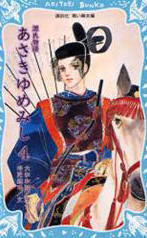
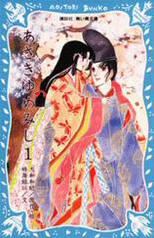
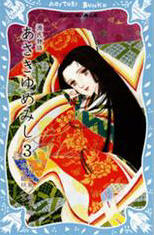
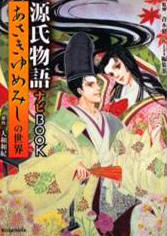
One of the most popular mangas was "The Rose of
Versailles".
It is a story about two officers of the body guard
corps of the Princess Marie-Antoinette.
One officer is a young man, and the other a young woman.The woman has
been raised as a boy from her childhood because her father was an
aristocrat and wanted his son to be one of the bodyguard corps for the
King in the Palace. But contrary to his expectation, the newborn baby
was a girl. Then, the father raised the baby girl as a boy in order that
she should be able to become an officer of the bodyguard corps. It is a
love story of two persons, a young officer and a young female officer.
The French revolution broke out, which caused a drastic change for their
lives...
S.Y.
* * * * * * * * * * * * * *
* * * * * * * * * * * * * * * *
TOP * * * * * * * * * * * *
* * * * * * * * * * * * * * * * * * *
Hino Tomiko (1440-1496)
Tomiko was the daughter of Hino Shigemasa, born in
Yamashiro province. She became the wife of the 8th Shogun (= the emperor
or the king) Ashikaga Yoshimasa at age 16 in 1455. She had her first
child on the ninth day of the first month of 1459, the child died the
same day however. Unlike her passive husband, who had very little
interest in political affairs, Tomiko was savvy and manipulative, and
placed the blame for the child's death on the wet-nurse, Imamairi no
Tsubone, whom she exiled to Oki island on lake Biwa (Imamairi no Tsubone
committed suicide on the way).
By the mid 1460's, Yoshimasa had decided that he
didn't want to be bothered with the duties of office and decided to
rescind his position of Shogun. However, as Tomiko had not born him a
male heir, he convinced his younger brother, Ashikaga Yoshimi, to first
assist him in office, and then gradually claim the title of Shogun.
Tomiko was averse to this, but at the time had no leverage to contest
the appointment, until a year later, when she gave birth to the future
Ashikaga Yoshihisa. With her standing in the Hino family, and backed by
Yamana Sozen, two factions developed in the capital, one faction
supporting the newly appointed Shogun, Yoshimi, and the other supporting
the succession of Yoshihisa. Thus, this desire of lady Tomiko to place
her son in line for the succession led eventually to conflict in the
land, and the Onin War began.
In the feudal ages, there were two heads, that is,
the Shogun ( the emperor or the king ) who had an actual
political and military power, and the Tenno who had no actual
power.
The Shogun became the Shogun only when he was appointed or approved by
the Tenno.
No one obeyed the Shogun unless he should be approved by the Tenno. On
the other hand, the Tenno had no actual power so he and his family were
supported by the Shogun. One could not stand without the other.
There were aristocratic people called “Kuge” or “Kizoku” who were
positioned under the Tenno and supported him. On the other hand, there
were feudal lords under the Shogun. The feudal lords obeyed the Shogun’s
orders and paid taxes to the Shogun. There are a lot of warriors called
“Samurai” under the feudal lord. In old feudal society, people wore
different clothes and hats, and had different hair styles according to
the social ranks they belonged to. Only the Shogun and feudal lords were
allowed to wear clothes and hats that aristocratic people wore. Common
Samurais wore different clothes and hats.
In the Hino
family, there
were two
daughters. The
elder daughter
became blind
after having a
disease with
high fever. So,
the younger
daughter, Tomiko,
was determined
to be married to
the prince
instead of her
elder sister.
The blind
daughter ( a
little girl in
white clothes )
was sent to a
Buddhist temple
accompanied by a
monk to be a
Buddhist nun.
Below some
pictures of a
movie about Hino
Tomiko.
* * * * * * * * * * * * * *
* * * * * * * * * * * * * * * *
TOP * * * * * * * * * * * *
* * * * * * * * * * * * * * * * * * *
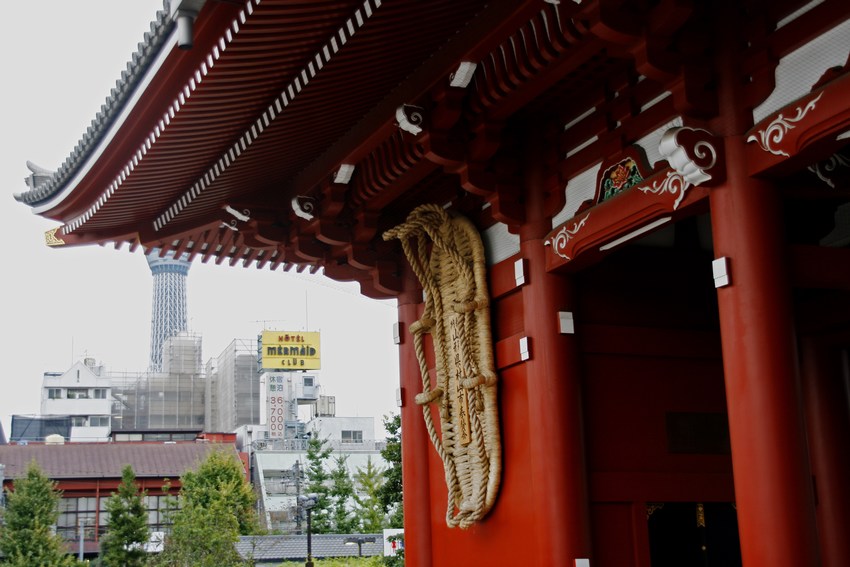
O-Waraji
This pair of
huge traditional
straw sandals
called 'O-Waraji'
has been made by
800 citizens of
Murayama City,
in a month. O-waraji
is made of straw
and 2500
kilograms in
weight, 4,5
meters high.
They are the
charm against
evils, they are
symbolic of the
power of 'Ni-Ou'.
Wishing for
being good
walkers, many
people will
touch this 'O-waraji'.
* * * * * * * * * * * * * *
* * * * * * * * * * * * * * * *
TOP * * * * * * * * * * * *
* * * * * * * * * * * * * * * * * * *
SOCIETY
Life Cycle
Infancy
One month after birth the Japanese child may be taken to a local
Shinto shrine to be introduced to the guardian gods and symbolically to
all of society.
This is called ‘miyamairi’. Parents and grandparents
bring the child to the shrine, to express gratitude to the deities for
the birth of a baby and have a shrine priest pray for his or her health
and happiness.
Today, most Miyamairi are practiced between one month or 100 days after
birth. In famous and busy shrines, the ceremony is held every hour,
often during weekends. A group of a dozen babies and their families are
usually brought in the hall, one group after another. Before the altar,
a Shinto priest wearing a costume and headgear appears between the group
and the altar, reciting a prayer and swinging a tamagushi right and
left.
http://en.wikipedia.org/wiki/Tamagushi
During the prayer, the priest cites the name of the baby, the names of
the parents, the family's address, and the baby's birthday. Afterwards,
the parents and grandparents come forward, one by one, bow to the altar,
and place tamagushis upon it.
At the end of the ceremony, rice wine in a red wooden cup is given to
each person in attendance; small gifts are often given to the family.
Annual celebrations for children occur on 3 March for girls (Doll
Festival), on 5 May for boys (Chidern's Day) and on 15 November for
girls aged three and seven and boys aged three and five. This is called
Shichigosan.
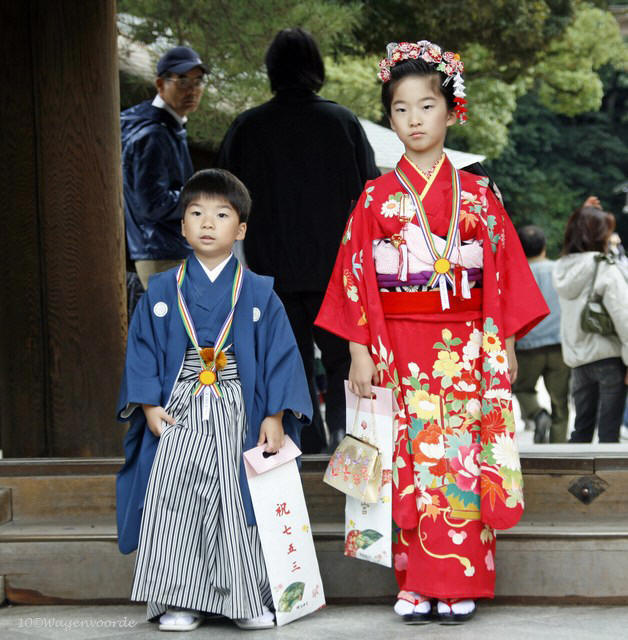
Childhood
Under the modern school system in Japan the most important rites of
passage are school enrollment and graduation. The nine years of
compulsory education comprise six years of elementary school and three
years of middle school.
Children who turn six year old by April 1st each year are enrolled
in elementary school, and start their school career by participating in
an enrollment ceremony.
The Japanese educational system
was reformed after World War II. The old system was changed to a 6-3-3-4
system (6 years of elementary school, 3 years of junior high school, 3
years of senior high school and 4 years of University) with reference to
the American system.
Japan has one of the world's best-educated populations, with 100%
enrollment in compulsory grades and zero illiteracy. While not
compulsory, high school (koukou) enrollment is over 96% nationwide and
nearly 100% in the cities.
About 46% of all high school graduates go on to university or junior
college.
The Ministry of Education closely supervises curriculum, textbooks,
classes and maintains a uniform level of education throughout the
country. As a result, a high standard of education is possible.
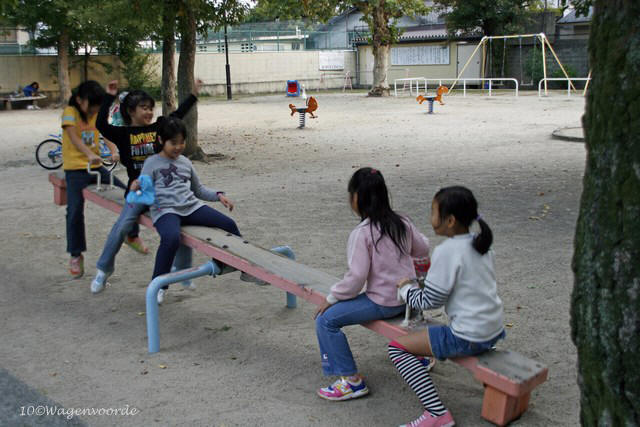
DEATH IN JAPAN
(1)
Pampas grass, now dry,
once bent this way
and that.
Shoro, died in 1894
A majority of Japanese now feel that the modern
biomedical and technological innovations pertaining to human life and
death have been forcing a change in their common understanding of what,
historically, was the natural way of death and dying. The meaning of
death and the dying process is changing as have the traditional criteria
for determining death, namely, cessation of heartbeat and respiration.
An individual's death should be a personal and
private matter as well as a familial, communal, and social matter.
That’s the way it has been for many thousands of years in Japanese
society and culture.
The ideas expressed in Zen-Buddhist phrases such as "accept death as it
is" and "life-death as one phenomenon" have been key motifs that were
integrated into the traditional Japanese understanding of life.
However, the traditional perception of death as an
acceptable process has been vanishing as the Japanese have applied
modern biomedical technologies more frequently in well-equipped hospital
settings. Although the involvement of family members in the process of
dying and particularly in the death event continues in a variety of
ways, the care of dying patients in Japan is becoming much more similar
to that in many countries of the world. Now, in Japan, a majority of
people end their lives in the hospital, surrounded by high-technology
machine. It is not what most people want. Many, if asked, said they
would prefer to die at home.
In addition, there has been a tradition of not
explaining to terminally ill people the true nature of their condition,
on the grounds that this is the most appropriate way to proceed.
However, views on this matter are changing as well. There is a gradual
move toward telling patients the truth. Many people in Japan say, that
they want to be informed about the full diagnostic information about
themselves/their illness. Nevertheless, a minority of the people say
they would definitely be prepared to disclose such
information to a family member.
Death in Japan… Times are changing.
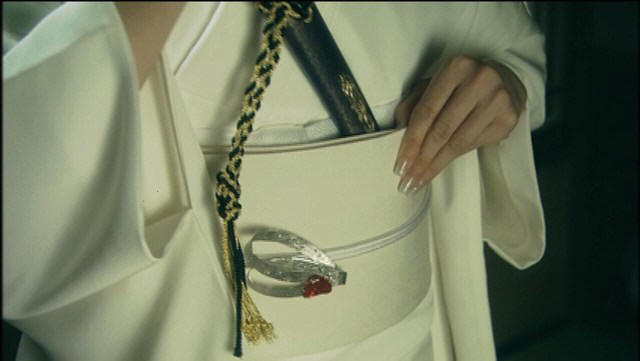
Inhale, exhale
Forward, back
Living, dying:
Arrows, let flown each to each
Meet midway and slice
The void in aimless flight --
Thus I return to the source.
Gesshu Soko, died in1696
Death costume
In Japan there is a tradition that people still
observe in modern days. It may be rooted in an ancient myth or
superstition. When someone has died, he has to walk on a long narrow
road, a path leading to Heaven. However, during his journey on the path,
many evil spirits appear and allure him to Hell. He has to fight against
such evil spirits so that he may
not go astray.
So, even today, when someone has died, their family puts a small sword
or a knife on the dead body in the coffin. With this weapon, the dead
person can fight evil spirits. The dead person wears a white costume.
This custom has been preserved, even in today's Japan.
In funerals, men and women wear black clothes for such occasions. In the
pictures here, an actress wears a white death costume. It is very rare for
a woman to wear a white death costume while alive.
* * * * * * * * * * * * * *
* * * * * * * * * * * * * * * *
TOP * * * * * * * * * * * *
* * * * * * * * * * * * * * * * * * *
DEATH IN JAPAN (2)
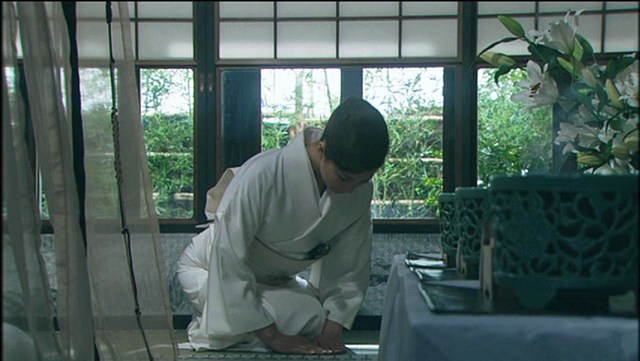
Coming, all is clear, no doubt about it.
Going, all is clear, without a doubt.
What, then, is all?
Hosshin, 13th century
A Japanese funeral takes place in three stages, spread over a
couple of days.
The first is the otsuya, literally "transit evening", a kind of wake.
People arrive at a designated place (announced in the newspaper
obituaries), and pay their respects to the departed.
If you want to pay your respects, you must kneel on a cushion, take three pinches of
incense from the fuel urn, hold each one up to your face, and place it
in the incense burner. Afterwards you put your fingers together in a
bowing- prayer. Then, you take a stick of incense from a nearby
box, light it with one of the candles and fan the flame with your
hand to extinguish it. (Never blow on anything at a Japanese funeral.
The breath is considered to be impure.)
With your hand, fan the incense fumes toward your
body, as the smoke is said to have a purifying effect, warding off any
wandering spirits.
The second stage is the ososhiki, the funeral
ceremony itself, held in a hall. There, there are knee-high tables, covered in
cloth. Behind the tables are white flowers, neatly arranged, and
a coffin with a picture of the deceased on
top.
It is not only a funeral ceremony, where people come to pay honor to the
deceased. It has a practical side as well. The persons
present pay a certain amount for the funeral.
The third stage consists of going to the kasoba,
or crematorium
Those who have watched the film "Cherry Blossoms" will have come away
with an impression of what this part of the funeral is like. With (in our view)
a lack of
ceremony, the coffin is pushed into the oven and the door closed. The
visitors bow and say goodbye.
At a specified time, a signal alerts mourners to go to another room. In
this room are to be found the bones of the deceased. The immediate
family takes up chopsticks and places the bones of their beloved into an
urn. Others can also take part.
* * * * * * * * * * * * * *
* * * * * * * * * * * * * * * *
TOP * * * * * * * * * * * *
* * * * * * * * * * * * * * * * * * *
KIMONO
There are many types of Kimonos, some are formal and
expensive. Others are casual and not expensive.
Cheap Kimonos are made in factories. But formal Kimonos of high quality
are made by human hands. Each one is different from others.
In Japan, hand-made products are highly valued. Just like Japanese
swords or tools used for tea ceremony or paintings, expensive Kimonos
are made by expert technicians - masters with long experience and highly
evaluated by people. You may think that Kimonos are like paintings made
by renown painters.
Some of these masters have been awarded with national prizes.
Young people buy cheap Kimonos or use rental systems.
If you go and search the internet, you may find Japanese sites for
buying or renting Kimonos.
College or high school girls often wear these types
of Kimonos which are not expensive. Most of them may cost you 20,000 -
30,000 yen when you buy them.
But in the case of formal Kimonos together with Obi body bands, perhaps
they may cost you more than 100,000 yen. or 50,000 in the cheapest case.
We’ll show you some examples of kimonos that are are
usually worn by college students. So, these clothes are not expensive,
but a rental system is often used by young people because they wear
Kimono only on some special occasions.
In this type of Kimono, students wear Kimono ( upper jacket ) along with
Hakama ( trousers ).
Usually they wear traditional sandals when they wear
almost all types of Kimono clothes. But in the case that they wear
Hakama trousers ( skirt ) along with Kimono, they sometimes wear Western
types of shoes or boots.
In such occasions as a graduation ceremony and the
subsequent party, not only college students but also teachers wear
Kimono.
K
I
M
O
N
O |
 |
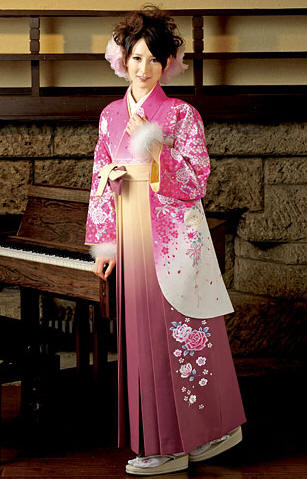 |
|
 |
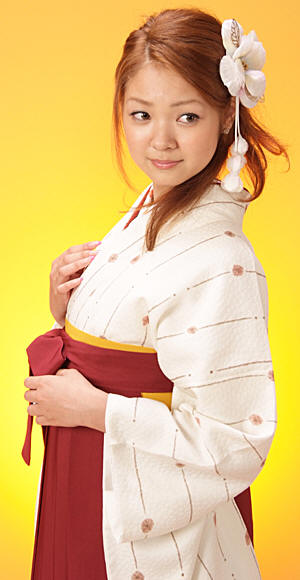 |
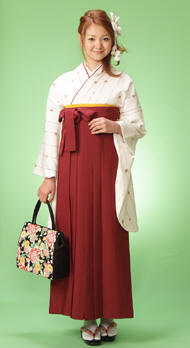 |
|

zori |
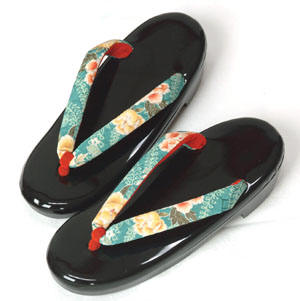
zori |

tabi |
Japan, 2011 S.Y.
* * * * * * * * * * * * * *
* * * * * * * * * * * * * * * *
TOP * * * * * * * * * * * *
* * * * * * * * * * * * * * * * * * *
tenno
TENNO
The Japanese word 'Tenno' by which the monarch of Japan has been
called, is an honorific title of 'Emperor'.
The first person who used this word is considered to be Prince-Regent
Shotoku (574-622), an ardent believer in Buddhism. That is probably why
he intended to rule the country as a boddhisattva.
What is the meaning of this?
An explanation:
The term "bodhisatta" (Pāli language) was used by the
Buddha in the Pāli canon to refer to himself both in his previous lives
and as a young man in his current life, prior to his enlightenment, in
the period during which he was working towards his own liberation. When,
during his discourses, he recounts his experiences as a young aspirant,
he regularly uses the phrase "When I was an unenlightened bodhisatta..."
The term therefore connotes a being who is "bound for enlightenment", in
other words, a person whose aim is to become fully enlightened.
Prince-Regent Shokotu was seeking enlightenment, not only for himself,
but also for others.
During his regency, he sent the first envoy to Sui China. The Sui
Dynasty (581-618 CE) was an ephemeral Imperial Chinese dynasty which
unified China in the 6th century.
According to The Chronicles of the Sui Dynasty, the letter sent in 607
by Prince-Regent Shokotu to the Emperor Yangdi began: "The Ruler of the
Land of Sunrise sends his message to the Ruler of the Land of Sunset."
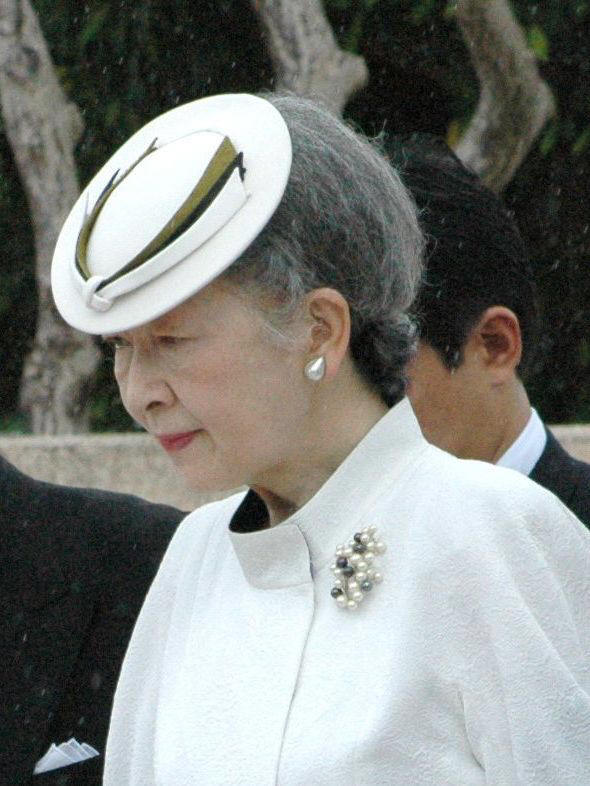 To
the Chinese Emperor, who regarded himself as the supreme ruler of the
universe, this tone of equality and the contrast between Sunrise and
Sunset sounded like the height of insolence. In his reply, therefore,
the Emperor wrote at the opening, intending to show how the
Prince-Regent should address him: "The Emperor speaks to the Prince of
Yamato." (The Yamato period is the period of Japanese history when the
Japanese Imperial court ruled from modern-day Nara Prefecture, then
known as Yamato Province. Yamato = Japan, in this case.) To
the Chinese Emperor, who regarded himself as the supreme ruler of the
universe, this tone of equality and the contrast between Sunrise and
Sunset sounded like the height of insolence. In his reply, therefore,
the Emperor wrote at the opening, intending to show how the
Prince-Regent should address him: "The Emperor speaks to the Prince of
Yamato." (The Yamato period is the period of Japanese history when the
Japanese Imperial court ruled from modern-day Nara Prefecture, then
known as Yamato Province. Yamato = Japan, in this case.)
But the Prince-Regent, who insisted on terms of equality, ignored this
and just wrote in his next letter to the Chinese Emperor: "The Tenno
(the Ruler of the Heaven) of the East speaks to the Emperor of the
West."
Chinese Emperors and Japanese Tennos were totally different in function.
Successive Tennos reigned, but didn't rule. The actual ruler could be a
brother, regent, or shogun.
And, also interesting, in ancient times, there were several female
Tennos as well.
Empress Michiko, source:
http://www.navy.mil/view_single.asp?id=25793
* * * * * * * * * * * * * *
* * * * * * * * * * * * * * * *
TOP * * * * * * * * * * * *
* * * * * * * * * * * * * * * * * * *
Modern art
MARIKO MORI
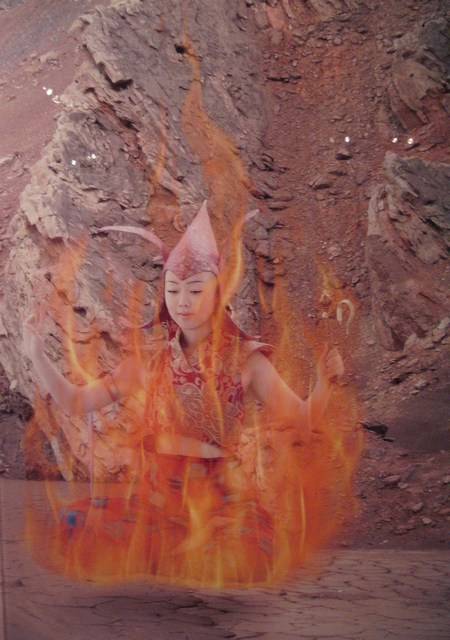
Mariko Mori lives and works in New York. Oneness is an
allegory of connectedness, a representation of the disappearance of
boundaries between the self and others. It is a symbol of the acceptance
of otherness and a model for overcoming national and cultural borders.
It also is a representation of the Buddhist concept of oneness, of the
world existing as one interconnected organism.
Little
is known about the personal life of Mariko Mori. She is believed to been
born in Tokyo in to be married to the composer Ken Ideka.
The artist graduated from the Bunka Fashion College (Tokyo) in 1988 and
spent most of her teenage years working there as a fashion model. Later
that year, feeling restrained by the Japanese ethic of uniformity, she
moved to London attending the Byam Shaw School of Art (1988-89), and
Chelsea College of Art, London (1989-92). Since she studied on an
Independent Study Program at the Whitney Museum of American Art, New
York (1992-93), Mariko continues to work and live both there and in
Tokyo.
The avant-garde artist Mariko Mori combines pop art, self-portraits,
modern technology and Buddhist ideologies in her art. Post-modern
Cyberfeminism, futuristic images, you can get it all, visiting one of
her exhibitions.
In her early self-portraits (photos) she shows herself in the female
roles in her native Japan: the official lady, the schoolgirl, the
prostitute. She is not a “normal” woman, however, but she shows herself
as a cyborg, a kind of robot, mechanical and sexless. As we can’t escape
the advancement of technology we must embrace it and use it…
"We've
fallen into a fin-de-siecle period of crisis in which people believe
only the things they see right in front of them" - Mariko Mori -
The cyborgs are developing, they become less human. As Mariko makes
videos, we can watch the more alien-like cyborgs moving, dancing. The
titles of her works are pessimistic in tone. They are warning us of
mappo, the dark period of moral decline before the arrival of the
future Buddha. This moral decline is due to a mixture of consumerism and
advanced technology. Mariko is not only pessimistic, because she has an
answer. She combines technology with traditional Buddhist beliefs.
On the exhibition in Groningen there are four panoramic colour
photographs, called Esoteric Cosmos (1996-98), with the names
Entropy of Love, Burning Desire, Mirror of Water and Pure Land.
They symbolise the four elements of nature as defined by Buddhist
teaching. Mariko transforms human images in a strange landscape, a kind
of utopian world.
One of the examples of her videos you can watch is Miko no Inori.
Mariko is outfitted entirely in white, looking like an alien, caressing
a crystal ball in her hands. In the meanwhile Mariko’s voice can be
heard, singing.
A
very impressive
project of hers is the “Wave UFO”. Only recently has technology
advanced far enough to be able to realize this work of art. Now the
audience can utilise their own brain activity …
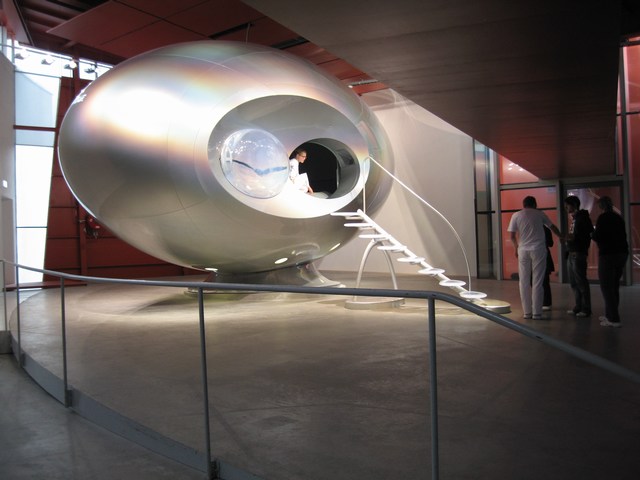
I think
all kinds of fantasy and dreams are very important to our life.
(Mariko interviewed by Blair 1995).
For a short video impression of the exhibition, have a look at:
http://www.cedargallery.nl/engother_artists.htm
* * * * * * * * * * * * * *
* * * * * * * * * * * * * * * *
TOP * * * * * * * * * * * *
* * * * * * * * * * * * * * * * * * *
LEE UFAN
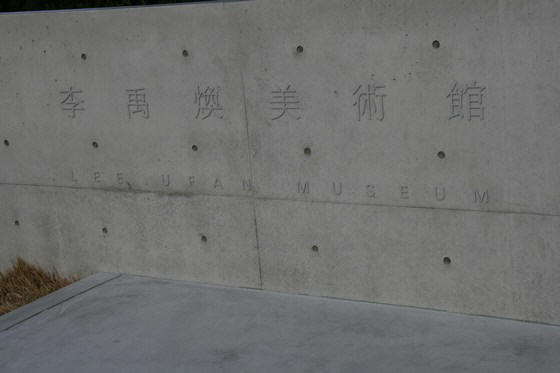
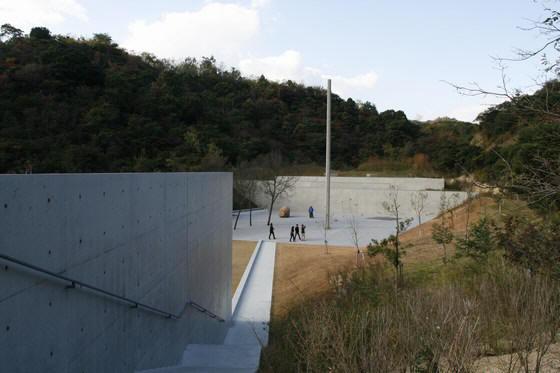
Naoshima, Lee Ufan museum
Naoshima, Japan, houses a lot of interesting spots.
One of these is the Lee Ufan Museum. A museum resulting from
collaboration between the internationally acclaimed artist Lee Ufan,
presently based mainly in Europe, and the architect Tadao Ando.
The Ando-designed semi-underground structure houses
paintings and sculptures by Lee spanning a period from the 1970s to the
present day. Lee's works resonate with Ando's building, giving visitors
an impression of both stillness and dynamism. Positioned in isolation in
a valley surrounded by mountains and sea, the museum offers a harmony
between nature, architecture, and art, where visitors is offered an
opportunity to return to their original natures and to find time for
quiet reflection in a society overflowing with material goods.
“I prefer an open relationship of encounter between
inner and outer phenomena to a completed, autonomous text. A work of art
can neither become an idea as such nor reality as such. It exists
between idea and reality, and ambivalent thing that is penetrated by,
and influences, both.
My work differs from the making of modernist
totalities or closed objects. It is important to create a stimulating
relationship between what I paint and what I do not paint, what I make
and what I do not make, the active and the passive.
By adding slight (one, two ot three) touches to the
canvas with ahnd, brush and paint, reverberating empty space is created
where paint is not applied.
….
It is human to live with dreams of transcendence.
Therefore, artistic expression should lead to reflection and leaps of
imagination. Just as human beings are physical beings, a paint of
contact between inner and outer worlds, works of art must be living
intermediaries that mediate between and exalt the self and the other."
Lee Ufan, Paris, 1999
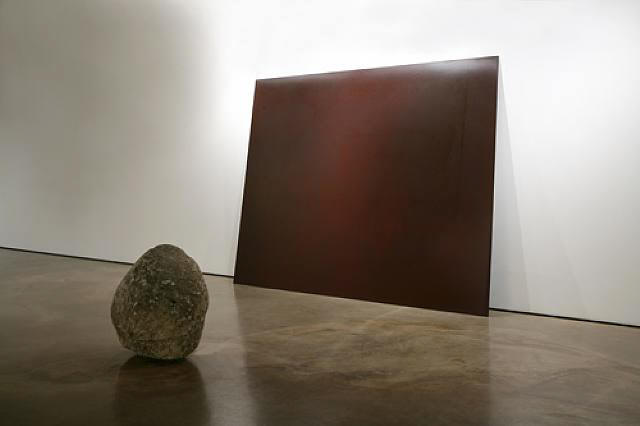
Lee Ufan’s sculptures and paintings are austere,
minimal, and not all that easy for westerners to ‘comprehend’. It is
pervaded with a life view abd a way of looking at art that are quite
different from what westerners are used to. To Ufan Lee, things and in
particular objects from nature are phenomena, parts of a limitless
whole.
He endorses the statement of Tao Chuang-tzu, an influential Chinese
philosopher who lived around the 4th century BC:
‘Wood and stone are wood and stone and at the same time not wood and
stone, and that is why wood and stone are essentially an inconceivable
universe.’
The central theme of Lee’s work, then, is infinite space or infinity
itself.
Lee Ufan seeks a moment of silence and insight, and wants to offer it to
others.
Het writes:
‘Stand still a moment. Boisterous, busy people, stop and stand still
for just a moment. Look at the blue sky. Close your eyes and take a deep
breath. Do only this, and you will change and the world will come to
life.’
Come and take a look at his works in New York, Paris,
London. Or in Japan, of course.
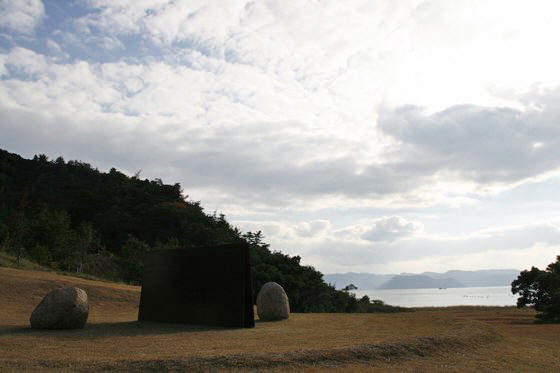

photos naoshima © wagenvoorde
* * * * * * * * * * * * * *
* * * * * * * * * * * * * * * *
TOP * * * * * * * * * * * *
* * * * * * * * * * * * * * * * * * *
ISAMU WAKABAYASHI
An interesting artist, about who I unfortunately can't find
much information. One thing is clear, however. Nature is important for
him. He can see a tree as something equal to himself. He observes nature
with attention and love.
This is a Japanese approach. Take the Sakura trees, for example, with
their beautiful blossoms. Japanese people enjoy viewing their blossoms
very much.
And in Japan there are many old trees. Some Japanese people believe(d)
that gods should abide in such old trees. It is interesting to see how
the Japanese take care of these old trees.
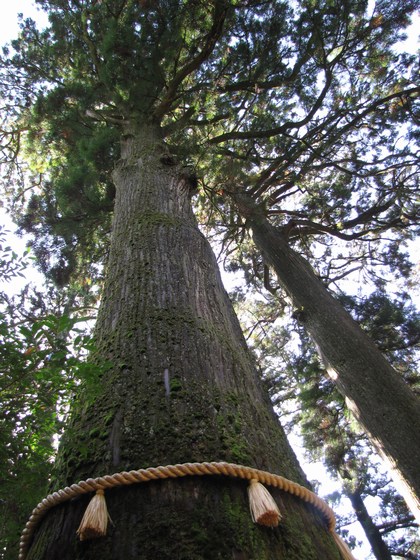
There was an exhibition in Kröller Müller Museum in The Netherlands, in
2001, and this is a fragment of a quote of Isamu in their catalogue.
'Otterlo Mist
Being beside a walnut tree, I once tried to
approach the time that the tree had lived. That was the minimum work, I
continued for a few years. The labour accompanying this work provided me
with something and deprived me of something.
Now I have interest in another tree, a beech tree
in the forest of Otterlo. Behind this tree stand also a large number of
trees and there might be a certain possibility to contemplate and
imagine all sorts of affairs and lives related. Even though this forest
was artificially brought into existence, it seems now to have built up a
world where natural and botanical features are more remarkable. I admire
the exquisite form of the beech tree, but at the same time, I have to
become conscious of my position and limitation. By the side of this
tree, I attempt to keep a record of a tree and its background.
....'
Isamu Wakabayashi
Dec. 2000
(source: Catalogue Kröller Müller
Museum Otterloo 2001)
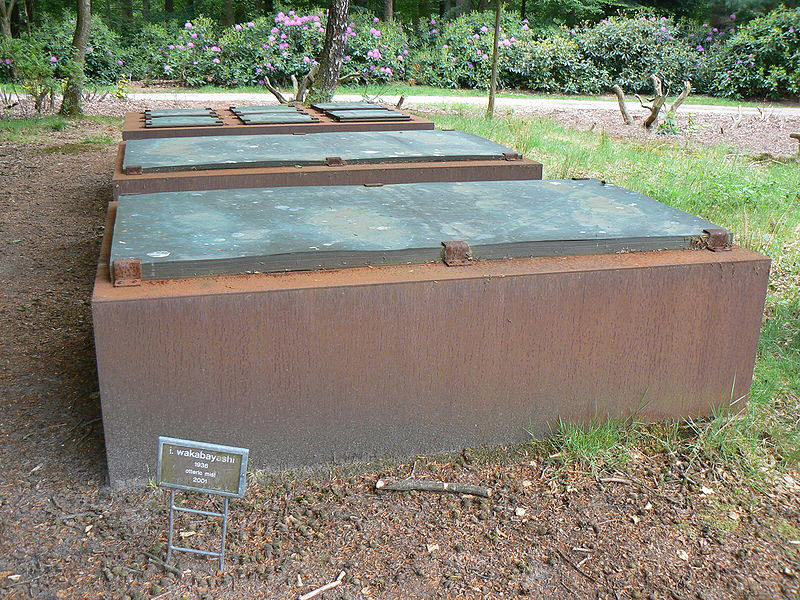
Otterlo Mist
* * * * * * * * * * * * * *
* * * * * * * * * * * * * * * *
TOP * * * * * * * * * * * *
* * * * * * * * * * * * * * * * * * *
More information about these, or other, artists, more pictures of
works of art are very welcome!
cedars@live.nl
* * * * * * * * * * * * * *
* * * * * * * * * * * * * * * *
TOP * * * * * * * * * * * *
* * * * * * * * * * * * * * * * * * *
Prints
Japanese Nõ and Nature PRINTS BY TSUKIOKA KÕGYO
Tsokioka Kõgyo was born in Tokyo, on 18 April 1869
(under a different name). He studied painting at the Painting School of
Tokyo Prefecture and started his career by decorating porcelain. In
1887, he became a pupil of his stepfather, the illustrious printmaker
Tsukioka Yoshitoshi (1839-1892). In 1889, he went on to study with Ogata
Gekkõ (1859-1920), a renowned printmaker and painter in the Nihonga
style. Kõgyo made his first prints and paintings around 1890.
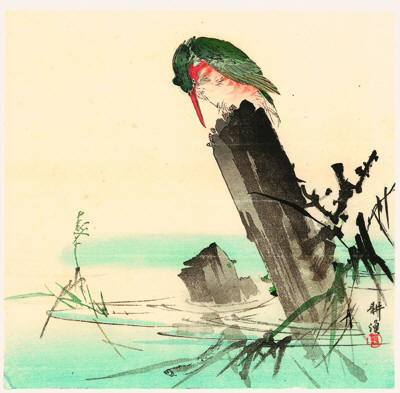
Kingfisher
At the beginning of Kõgyo’s career, his prints were mainly in
traditional genres, such as landscapes, flowers and birds.
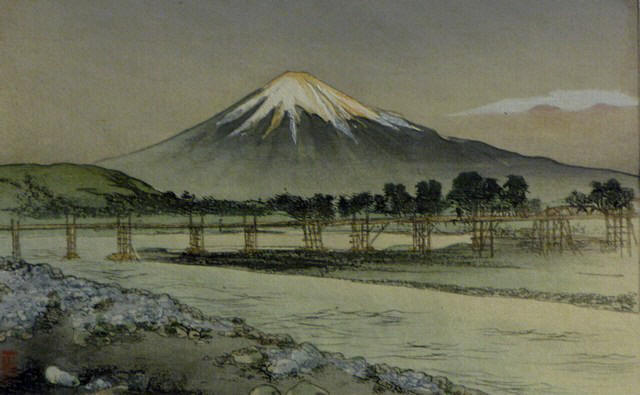
Photo: Wagenvoorde
From 1897, his focus turned to the Nõ theatre. In his three big Nõ
theatre series, Picture of Nõ Performances (Nõgaku zue), One Hundred Nõ
Dramas ( Nõgaku hyakuban) and a Great Collection of Nõ Pictures (Nòga
taikan), Kõgyo made over five hundred prints altogether. These prints
give a colourful impression of the most important scenes and characters
from many theatre pieces, most of which are still performed today.
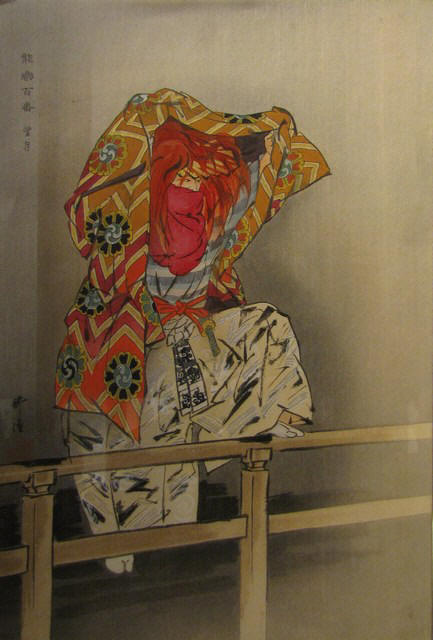
Photo: Wagenvoorde
The year of Tsukioka Kõgyo’s birth, 1869, coincided
with great political and economic upheaval in Japan. From 1603 to 1868,
the ‘shoguns’ had held sway over a feudal power system, controlling all
the distinguished families in Japan.
The emperor’s power was restored in 1868, at the start of the Meiji
period.
Emperor Meiji differed from the shoguns in his interest in the West,
including Western art. The modernization of Japan went hand in hand with
the rise of a strong nostalgia for the country’s own past and for
oriental values.
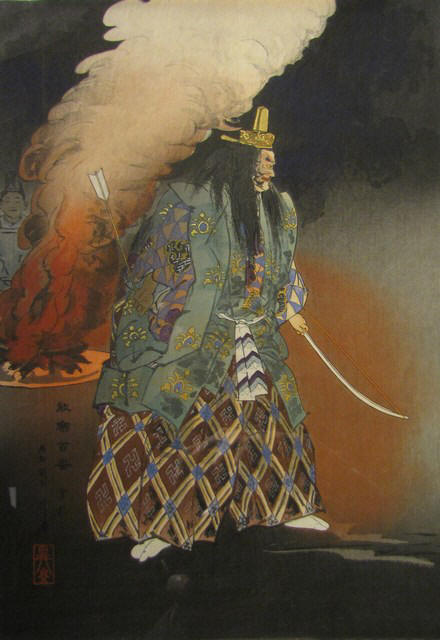
Kinsatsu from the series Nõgaku hyakuban, 1923
Photo: Wagenvoorde
Nō Theatre
One of these oriental values, the classical and subdued Nō theatre, had
thrived for centuries under Shogun rule and initially looked like
becoming a victim of the modernizations. It recovered, however, by
successfully convincing a new audience of its silent beauty. Nō theatre
dates from the 15th century as has build enormous prestige throughout
the years in Japan, Europe and the United States. The Nō theatre is a
theatrical form which was always abandoned from any historical place or
date. It's a more autonomous theatre form in which spiritual elements
are very important. Not only on stage, but also on printed paper Nō
theatre was and is an enormous success.

Picture of a Nõ Theatre, 1898
The prints from Kōgyo give a lot of information about
the plays (often showing an important scene from the story), as well as
the situations backstage. There are also prints of singers and
musicians, props and masks, and the construction of the stage itself.
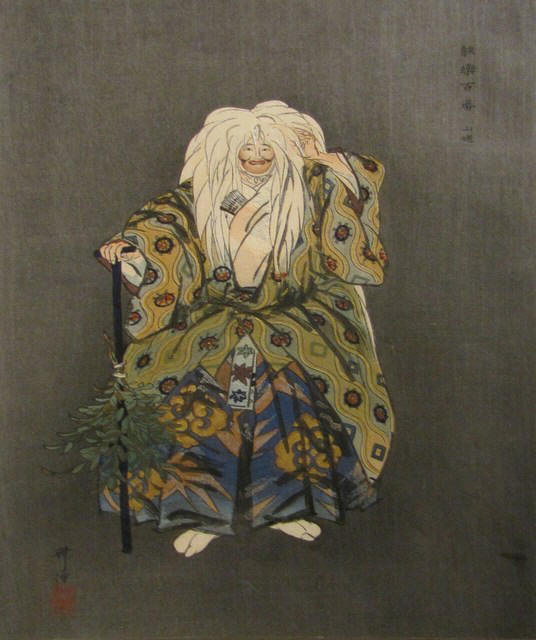

Left: ?
Right: Nõ Masks from the series Nògaku zue, ca. 1900
Photo: Wagenvoorde
At the time of Kõgyo’s death in 1927, the Nõ theatre
had gained a strong position in the performing arts and was popular with
a steadily growing Japanese audience. Kõgyo’s work reflects this
enthusiasm for the beauty and elegance of the Nõ theatre at the heart of
the Japanese tradition.
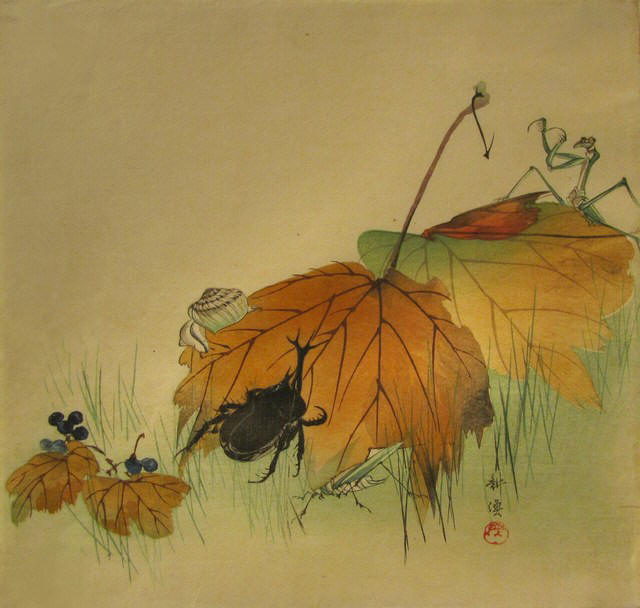
Photo: Wagenvoorde
* * * * * * * * * * * * * *
* * * * * * * * * * * * * * * *
TOP * * * * * * * * * * * *
* * * * * * * * * * * * * * * * * * *
More information about these, or other, artists, more pictures of
works of art are very welcome!
cedars@live.nl
* * * * * * * * * * * * * *
* * * * * * * * * * * * * * * *
TOP * * * * * * * * * * * *
* * * * * * * * * * * * * * * * * * *
Glossary
fukusa - silk cloth used by tea masters to
wipe utensils during tea ceremony
geisha - (lit. person of the arts')
professional female entertainer or companion
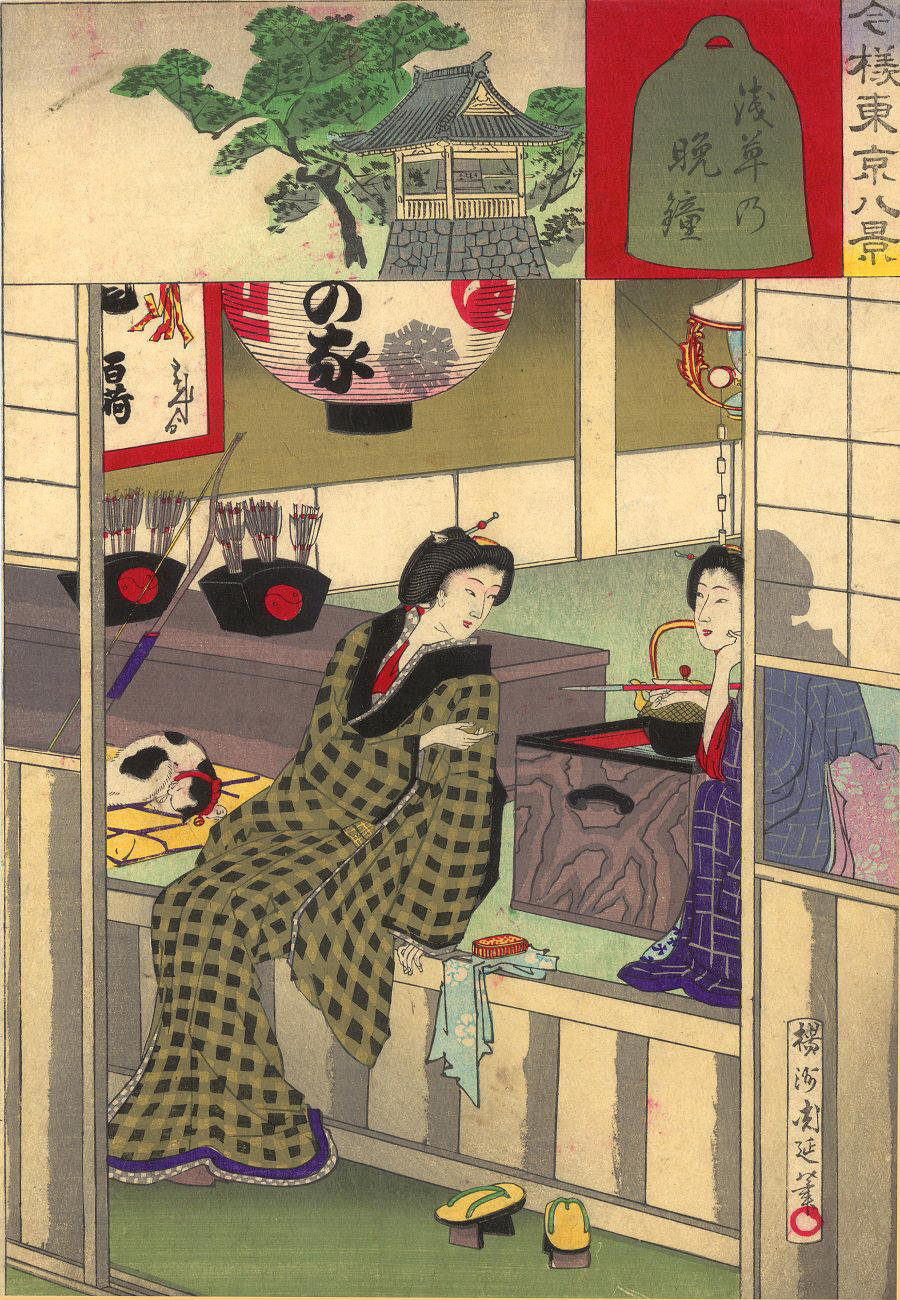
Two geishas relaxing after having entertained; the insets showing
the curfew bell at Asakusa.
Ukiyo-e woodblock print by Yōshū Chikanobu, 1888
geta - traditional wooden clogs
haiku - seventeen-syllable poem (http://www.cedargallery.nl/engjapan_poetry.htm)
ikebana - traditional art of flower
arrangement
Jizo - Jizō is
popularly venerated as the guardian of unborn, aborted, miscarried, and
stillborn babies
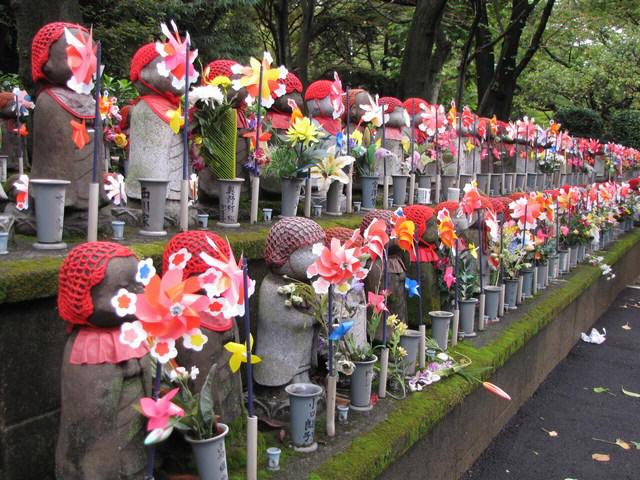
Jizo
©wagenvoorde
Kabuki - form of traditional Japanese theater
characterized by elaborate costumes, stylized acting and the use of male
actors for all roles
kaomise - (lit. 'face showing') performance of Kabuki held in
Kyoto in December, featuring leading Kabuki actors
katsu - meaningless shout, used in Zen to shock or surprise and
thereby lead to enlightenment
koan - illogical Zen Buddhist riddle, used as a meditational tool
to achieve enlightenment
koto - thirteen stringed musical instrument
kuruwa - enclosures or walled areas within a city, which were
inhabited by courtesans
Matcha - also maccha, refers to finely milled
or fine powder green tea. The Japanese tea ceremony centers on the
preparation, serving, and drinking of matcha
men - (lit. 'face') front of an object
mu - concept of 'nothingness' which lies at the core of Zen
onnagata - male actors who play women's roles
in Kabuki
pachinko - gambling game played on a vertical
pinball machine
seidan - term originating in fourth-century
Taoist gatherings: the art of 'pure conversation'
Shinto - polytheistic indigenous religion of Japan (http://www.cedargallery.nl/engjapan_religion.htm)
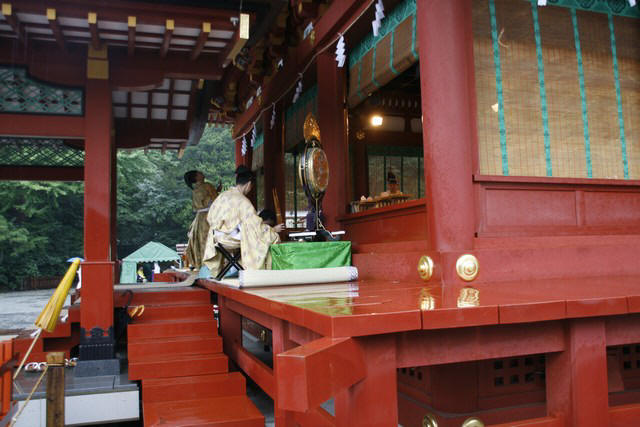
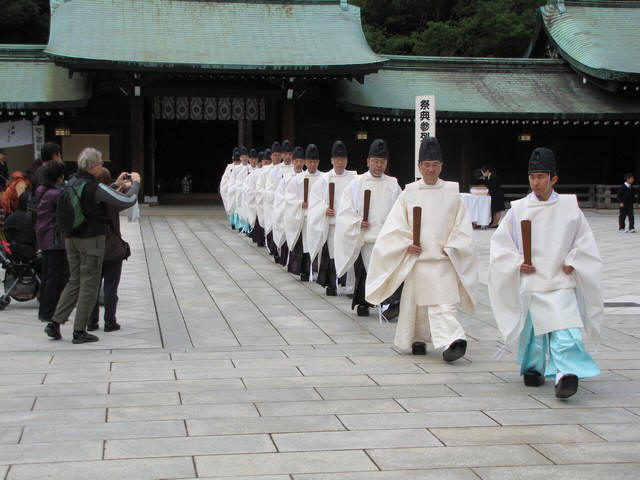
Shinto
©wagenvoorde
suki - playful architectural style which focuses on details,
strongly influenced by tea ceremony
tatami - woven floor matting, used as a unit
of room measurement
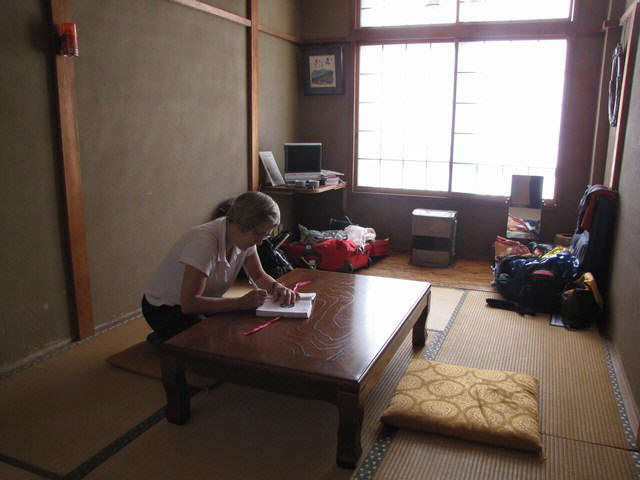
tatami on the floor
©wagenvoorde
tatebana - formal style of ikebana known as 'standing flowers'
tokonoma - decorative alcove found in most Japanese homes in
which flowers, a scroll or other artworks may be displayed
torii - entrance gate to a shrine
wabi - (lit. 'worn' or 'humble') emphasis on
simplicity and humble, natural materials. First incorporated into tea
ceremony, wabi has come to symbolize all that is
unostentatious in the traditional arts
waka - thirty-one-syllable poem
yago - actor's 'house name', which is shouted by members of the
audience at dramatic moments during a Kabuki play
yukata - summerweight cotton kimono
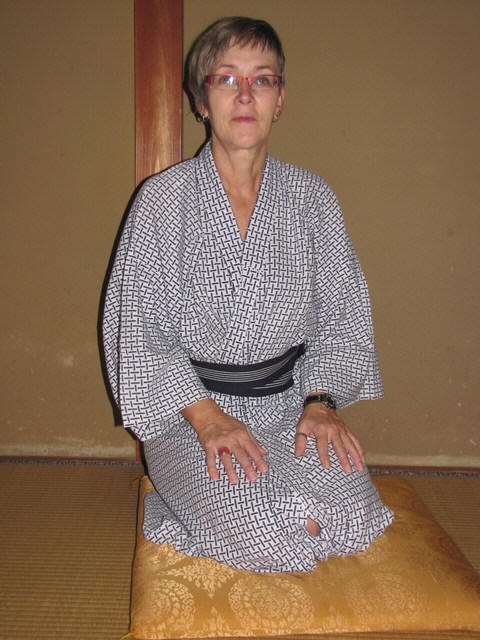
wearing a yukata
©wagenvoorde
Zen - Japanese school of Buddhism, introduced
in the twelfth century from China, which teaches the achievement of
enlightenment through inner contemplation
* * * * * * * * * * * * * *
* * * * * * * * * * * * * * * *
TOP * * * * * * * * * * * *
* * * * * * * * * * * * * * * * * * *
Our website, and certainly the section about Japan,
is a labour of love.
The study of Japanese religions and religious art has expanded
greatly in the West over the past five decades, and one example you can
find here:
http://www.brill.com/portraits-chogen
Several books are written, several websites created.
Nevertheless we hope that our visitors enjoy what they find and read
here.
Our site is just a modest tribute to (the beauty of) Japan.
JAANUS is the on-line Dictionary of Japanese
Architectural and Art Historical Terminology compiled by Dr. Mary
Neighbour Parent.
An excellent recourse:
http://www.aisf.or.jp/~jaanus/
top |
previous
Texts, pictures,
etc. are the property of their respective owners.
Cedar Gallery is a non-profit site. All works and articles are published
on this site purely for educational reasons, for the purpose of
information and with good intentions. If the legal representatives ask
us to remove a text or picture from the site, this will be done
immediately. We guarantee to fulfill such demands within 72 hours.
(Cedar Gallery reserves the right to investigate whether the person
submitting that demand is authorized to do so or not).
The contents of this
website (texts, pictures and other material) are protected by copyright.
You are welcome to visit the site and enjoy it, but you are not allowed
to use it, copy it, spread it. If you like to use a picture or text,
first send your request to
cedars@live.nl
|



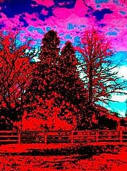














 To
the Chinese Emperor, who regarded himself as the supreme ruler of the
universe, this tone of equality and the contrast between Sunrise and
Sunset sounded like the height of insolence. In his reply, therefore,
the Emperor wrote at the opening, intending to show how the
Prince-Regent should address him: "The Emperor speaks to the Prince of
Yamato." (The Yamato period is the period of Japanese history when the
Japanese Imperial court ruled from modern-day Nara Prefecture, then
known as Yamato Province. Yamato = Japan, in this case.)
To
the Chinese Emperor, who regarded himself as the supreme ruler of the
universe, this tone of equality and the contrast between Sunrise and
Sunset sounded like the height of insolence. In his reply, therefore,
the Emperor wrote at the opening, intending to show how the
Prince-Regent should address him: "The Emperor speaks to the Prince of
Yamato." (The Yamato period is the period of Japanese history when the
Japanese Imperial court ruled from modern-day Nara Prefecture, then
known as Yamato Province. Yamato = Japan, in this case.)




















